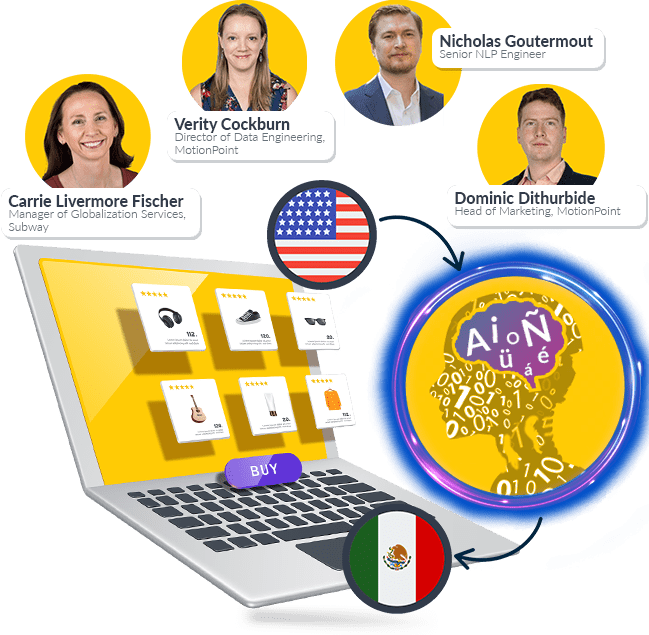What is Content Localization?
Content localization involves adapting your content to be more relevant to local audiences. Content localization translates and adapts content and brand for the target audience, making it understandable and relatable.
To succeed globally, customize your marketing to meet local needs, pain points, interests, and culture. Global content localization solutions include adapting for cultural differences, preferences, references, symbols, currencies, and trends in each of your target markets.
Customers want to feel connected to brands. According to a study by the Common Sense Advisory, 65% of people prefer reading content in their local language, and 55% of global consumers would only purchase from websites that provide product information in their own language. The same study also said that 87% of customers would not buy from an English-only website.
How to Build a Content Localization Strategy
Convincing an international audience about the benefits of your product or service means that it is critical to communicate in ways that resonate with local culture. Whether your business succeeds depends on how well you plan and execute your localization strategy.
Step 1: Determine Your Goals
Creating a content localization strategy is like making a global marketing plan. It involves analyzing your business and goals. Every step of the localization strategy contributes to your overall goal.
You should figure out these objectives and key performance indicators ahead of time. The most commonly used KPIs include revenue growth, profit margin, and customer satisfaction.
Step 2: Conduct Thorough Market Research
Market research is the primary step to expanding any business internationally. Your market research process acts as a localization discovery phase. You will learn about what global audiences value, including product details, cultural influences on behavior, and messaging. The information gathered in this phase arms you with knowledge on how to connect locals with your brand or business.
Market research involves gathering information and data on products, services, and competitors. This helps businesses to grow and expand in the market. Once you make a data-driven decision on where you feel your business will expand successfully, you need to figure out who to localize content for. If you have built an effective content marketing strategy, your content will stand up and provide value to your target audience.
Step 3: Determine What Languages Are Relevant
After choosing your target market, you must identify relevant languages for those markets. Some international markets have multiple languages or dialects within one country, such as with Chinese and Cantonese in China. In addition, there are many countries where Spanish is the prevalent language, but the cultural elements of each country are vastly different.
That does not necessarily mean translating and localizing your content to satisfy each language. Instead, you can decide to target whichever languages and cultures are the most relevant given your objectives and locations where you are focusing your business.
Step 4: Parse Existing Content Into Buckets
After determining which languages you will focus on, figure out which multilingual content will perform the best. You need to assess your content offerings like your website, marketing materials, social media posts, email campaigns, and videos. Decide whether you need to translate and localize all content, or if some content can just be translated.
Although localization can be confused with translation, translation is the part of the process that changes the text into the target language. Localization goes beyond translation and changes the content to match the linguistic and cultural nuances of the target locale. Sort your content into the following buckets:
- Full Translation and Localization
- Translation
- No Adjustments Needed
You may find that you do not want certain pieces of content to be translated and localized depending on the relevance of the content, budgeting, and time constraints.
Step 5: Determine Translation and Localization Process
You need to determine how you will translate and localize your content. There are several options to translate and localize content. You may have considered establishing an in-house translation department. You can also work with a translation and localisation company such as MotionPoint to support your translation and localization efforts.
Translation and localization take time and an enormous effort. Translating digital text, images, and other online elements is only a fraction of the actual cost of website translation. Expenses include technologies, smart translation management, and efficient software to keep translation and localization processes going smoothly. Therefore, take the time to weigh the costs and efforts involved in building an in-house translation and localization team.
It is also important to look at human and machine translation processes. This includes exploring the use of Google Translate or other automated translation systems to change content into different languages versus a human linguist comparing language and cultural elements to provide a more well-localized product.
Step 6: Republish Localized Content and Optimize
When translations and localizations are complete, your content can be uploaded to go public immediately. Then, it is crucial to make adjustments and updates as needed. Consistent optimization should be prioritized to keep up with functionality, SEO, and relevant cultural or elemental changes reflected by your target audience.

3 Key Benefits of Localizing Your Content
1. Opens Content to a Wider Audience
Localization opens your content up to a broader audience. When you deliver relevant, tailor-made brand experiences, you will receive better responses, more customers, and more customer engagement. This includes company standings in search engines.
In addition, when people search for the products and services they need in their native language, they get results based on the keywords used. This means localized SEO is imperative to a comprehensive localization strategy.
2. Builds Brand Authenticity and Awareness
Content localization is effective when potential customers can read and understand your business offerings. Taking the time to translate and localize content improves brand awareness and shows authenticity. It shows that you are making an effort to connect with your audience in their native language.
One aspect of this is adapting ad campaigns to speak to current affairs in a region, incorporating local examples in blog posts or website updates, or weaving in cultural nuances in your social media posts. Your awareness of the cultural landscape allows you to build trust and familiarity with your audience.
3. Increases Conversion Rates for Multilingual Audiences
Localized content gives your business a competitive edge to increase conversion rates in the multilingual marketplace. When global customers can easily navigate your website and understand your business, they will be more likely to stick around and increase the likelihood of completing a sale or conversion.
Approach Content Localization Carefully
Content marketing is a growing industry, especially when global expansion continues to be a top priority for businesses. Correctly approaching content localization takes more than linguistic fluency, however.
You need skilled, professional translators to preserve accuracy, tone, and your brand’s voice. MotionPoint provides exceptional capabilities, relevant technologies, and the efficiencies required to keep your business up to date with translation and localization.
Last updated on October 06, 2022

